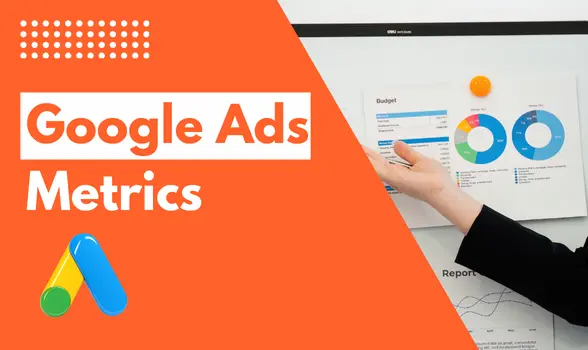Google Ads offers a powerful platform to drive targeted traffic and sales, but mastering it requires more than just launching campaigns. Understanding and monitoring key performance metrics is essential to optimizing your ads and maximizing return on investment (ROI).
In this detailed blog, explore the top 9 Google Ads metrics that every advertiser should actively track. Each metric captures a unique aspect of campaign performance, helping marketers make informed decisions to boost efficiency and growth.

1. Return on Ad Spend (ROAS)
Return on Ad Spend (ROAS) measures the revenue generated for every dollar spent on Google Ads. It’s a fundamental metric to understand campaign profitability.
For example, a ROAS of 5 means every $1 invested yields $5 in revenue, indicating a highly effective campaign.
Tracking ROAS helps marketers allocate budgets to the most profitable campaigns and adjust strategies to improve overall profitability. It complements metrics like cost per acquisition by focusing on value rather than just volume.
2. Cost per Acquisition (CPA)
Cost per Acquisition (CPA) calculates the average amount spent to acquire one conversion, such as a sale, sign-up, or lead.
This metric helps advertisers gauge how cost-effectively their campaign generates business outcomes.
A lower CPA is generally desirable, but the acceptable level depends on the lifetime value of a customer—sometimes spending more per acquisition is justified by higher long-term revenue.
Optimizing Google ads bids, keywords, and ads to reduce CPA without sacrificing conversions is a core Google Ads task.
3. Number of Conversions
This is the total count of completed goals or desired actions resulting directly from clicks on your ads, such as purchases, form submissions, or app installs.
Tracking the absolute number of conversions offers insights into campaign volume and overall success.
Marketers use it to evaluate whether campaigns meet volume targets and to identify successful campaigns that drive actual business results beyond clicks or impressions.
4. Number of Clicks
Clicks represent how many times users actually clicked on your ads, signaling engagement and interest.
Clicks cost money in a pay-per-click (PPC) model, so while a high number of clicks is positive, it must be balanced with conversion quality to ensure effective spend.
Click data guides budget allocation and helps determine which ads and keywords attract the most attention, serving as the foundation for conversion potential.
5. Conversion Rate
Conversion Rate is the ratio of conversions to clicks, expressed as a percentage. It reveals how effectively your ads and landing pages convert traffic into customers or leads.
For instance, a conversion rate of 10% means 1 in 10 clicks results in a conversion.
Higher conversion rates indicate well-targeted ads with compelling offers and user-friendly landing pages. Improving this metric is critical to lowering cost per acquisition and driving higher ROI.
6. Number of Impressions
Impressions count how many times your ad was shown to users on Google’s search results or partner websites.
This metric measures ad visibility but not engagement. A large number of impressions with low clicks might indicate poor ad relevance or targeting.
Advertisers monitor impressions to assess whether their ads have the right reach and optimize bidding strategies to improve exposure while balancing cost.
7. Click-Through Rate (CTR)
CTR is the ratio of clicks to impressions, indicating the effectiveness of your ad copy and targeting. It is a key quality signal for Google.
A higher CTR means users find your ad appealing and relevant. For example, a CTR of 5% implies 5 clicks per 100 ad views.
LTR improvements can reduce the cost per click through higher Quality Scores, thus improving ad rank and lowering spend for the same visibility.
8. Total Conversion Value
Total Conversion Value aggregates the revenue or estimated value attributed to all conversions during a campaign.
It helps to see the direct business impact of advertising beyond just the number of conversions.
Marketers often set values for different conversion types (e.g., purchases vs. leads) to assess the overall monetary impact and optimize campaigns for higher-value sales.
9. Quality Score
Quality Score is a Google-assigned metric from 1 to 10 that rates ad relevance, expected CTR, and landing page experience.
Higher scores typically mean your ads will perform better at a lower cost. Google rewards advertisers with high-quality ads by improving ad placement and reducing CPCs.
Improving Quality Score involves improving keywords’ relevance, writing compelling ad copy, and ensuring a seamless user experience on landing pages.
Understanding These Metrics in Context
While each metric provides valuable insights, looking at them in isolation is not enough. For example, a high number of clicks with a low conversion rate may mean you’re attracting unqualified traffic. Likewise, a great ROAS but few conversions could indicate a niche but highly profitable audience segment.
Seasonality, industry benchmarks, and specific business goals all influence what constitutes good performance. Regularly comparing metrics against past performance and industry standards is critical.
Best Practices for Monitoring Google Ads Metrics
- Use custom dashboards that track your key performance indicators (KPIs) in real time.
- Set up accurate conversion tracking for sales, leads, and micro-conversions like newsletter signups.
- Apply segmentation to track performance by device, location, time of day, and audience for granular insights.
- Conduct A/B tests on ads, landing pages, and targeting to improve metrics incrementally.
- Combine metrics like CTR and Quality Score to optimize bids and improve ad rank cost-effectively.
Conclusion
Mastering the top 9 Google Ads metrics unlocks powerful insights into campaign performance and profitability. By tracking ROAS, CPA, conversions, clicks, conversion rate, impressions, CTR, total conversion value, and Quality Score, marketers can make data-driven optimizations that enhance efficiency and drive sustainable growth.
Using these metrics strategically allows advertisers not only to measure success but to transform Google Ads into a growth engine that maximizes every advertising dollar spent.
This knowledge forms the bedrock of smart paid advertising management in 2025 and beyond.




